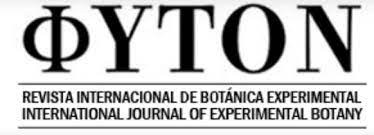Ver ítem
- xmlui.general.dspace_homeCentros Regionales y EEAsCentro Regional Buenos Aires SurEEA BarrowArtículos científicosxmlui.ArtifactBrowser.ItemViewer.trail
- Inicio
- Centros Regionales y EEAs
- Centro Regional Buenos Aires Sur
- EEA Barrow
- Artículos científicos
- Ver ítem
Floristic associations and filtering ability of riparian vegetation strips = Asociaciones florísticas en franjas de vegetación ribereña y sus capacidades de filtrado
Resumen
The analysis of lateral flow runoff of superficial nutrients and sediments from an agricultural origin and their retention by infiltration of riparian vegetation strips are of great importance in reducing the agricultural externalities on surface water quality. The aim of this study was to relate soil infiltration to the main biophysical properties of riparian environments in the Pampa Austral of Argentina, defined by the composition of its plant
[ver mas...]
The analysis of lateral flow runoff of superficial nutrients and sediments from an agricultural origin and their retention by infiltration of riparian vegetation strips are of great importance in reducing the agricultural externalities on surface water quality. The aim of this study was to relate soil infiltration to the main biophysical properties of riparian environments in the Pampa Austral of Argentina, defined by the composition of its plant community and the coverage of exotic species. We explored the relationships between hydraulic conductivity (Ks ) and aboveground, litter and root biomasses, organic matter concentration, terrain slope, soil bulk density, texture and electrical conductivity. We determined eight floristic associations through the classification of 65 censuses of vegetation. Three of the associations were dominated by native grasses, three by exotic grasses and two presented a layer of exotic willow trees in combination with native and invasive grasses. The mean Ks in soils from the floristic associations with trees and from the associations of native grasses without trees were higher than in soils from the associations of exotic grasses without trees. Significant relationships were found between Ks and the soil properties that are sensitive to the influence of vegetation, suggesting that the relationships between floristic composition and infiltration could be explained partly due to causal relationships.
[Cerrar]
El análisis de flujo lateral, por escorrentía superficial de nutrientes y sedimentos de origen agropecuario y su retención vía infiltración por las franjas de vegetación ribereña, son de gran importancia para reducir las externalidades en cuerpos de agua superficiales. El objetivo de este estudio fue relacionar la infiltración de los suelos con las principales propiedades biofísicas en los ambientes ribereños de la Pampa Austral, definidos por la
[ver mas...]
El análisis de flujo lateral, por escorrentía superficial de nutrientes y sedimentos de origen agropecuario y su retención vía infiltración por las franjas de vegetación ribereña, son de gran importancia para reducir las externalidades en cuerpos de agua superficiales. El objetivo de este estudio fue relacionar la infiltración de los suelos con las principales propiedades biofísicas en los ambientes ribereños de la Pampa Austral, definidos por la composición de su comunidad vegetal y la cobertura de especies exóticas. Se exploraron las relaciones entre la conductividad hidráulica (Ks) con la biomasa aérea, de mantillo y de raíces, la concentración de materia orgánica, la pendiente, la densidad aparente, la textura y la conductividad eléctrica del suelo. Mediante la clasificación de 65 censos de vegetación se reconocieron 8 asociaciones florísticas. De éstas, 3 fueron dominadas por herbáceas nativas, 3 por herbáceas exóticas y 2 presentaron un estrato arbóreo de un sauce exótico en combinación con herbáceas nativas e invasoras. La media de la Ks en los suelos con presencia de asociaciones florísticas con árboles y las herbáceas nativas sin árboles fueron mayores que en los suelos con presencia de herbáceas exóticas sin árboles. Se encontraron relaciones significativas entre Ks y las propiedades del suelo sensibles a la influencia de la vegetación, lo que sugiere que las relaciones entre composición florística e infiltración podrían ser explicadas parcialmente por relaciones causales.
[Cerrar]

Autor
Giaccio, Gustavo Carlos María;
Laterra, Pedro;
Cabria, Fabian Nestor;
Fuente
Phyton-International Journal of Experimental Botany 86: 112-123 (2017)
Fecha
2017
Editorial
Fundación Rómulo Raggio
ISSN
1851-5657 (online)
0031-9457 (print)
0031-9457 (print)
Formato
pdf
Tipo de documento
artículo
Palabras Claves
Derechos de acceso
Abierto
 Excepto donde se diga explicitamente, este item se publica bajo la siguiente descripción: Creative Commons Attribution-NonCommercial-ShareAlike 2.5 Unported (CC BY-NC-SA 2.5)
Excepto donde se diga explicitamente, este item se publica bajo la siguiente descripción: Creative Commons Attribution-NonCommercial-ShareAlike 2.5 Unported (CC BY-NC-SA 2.5)


